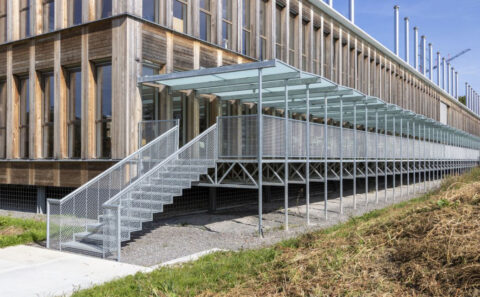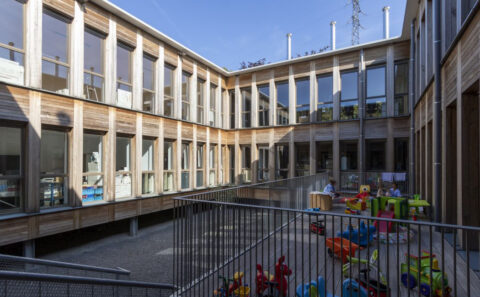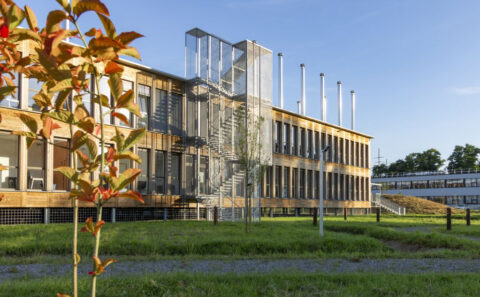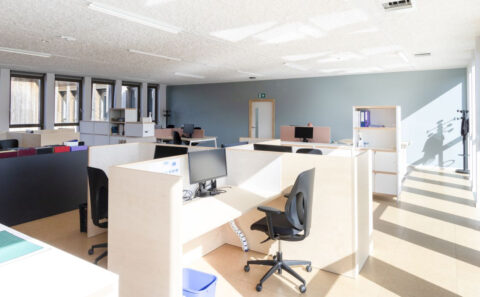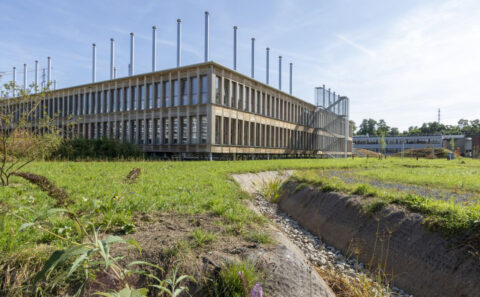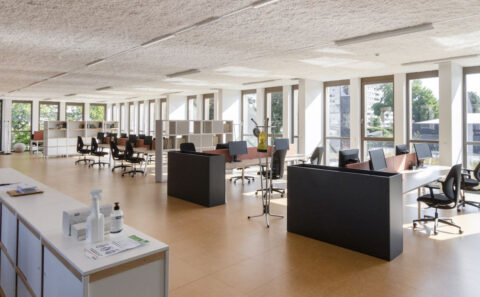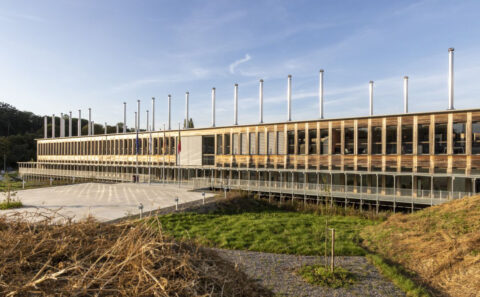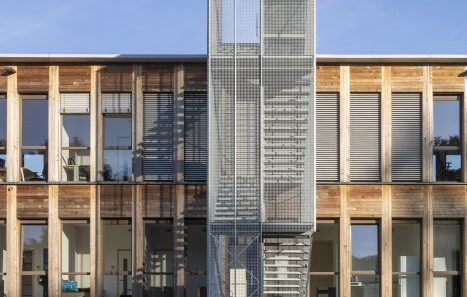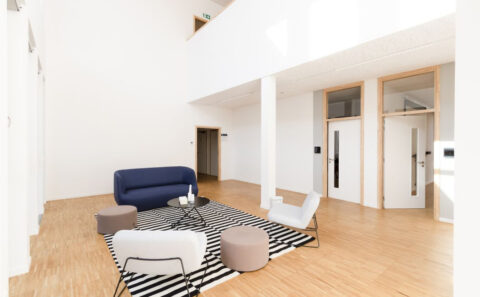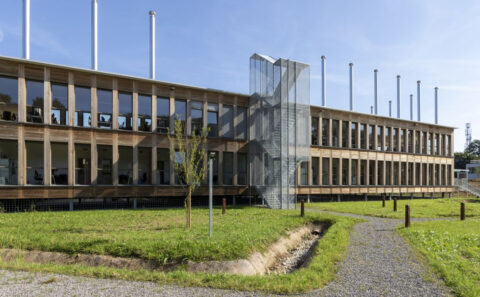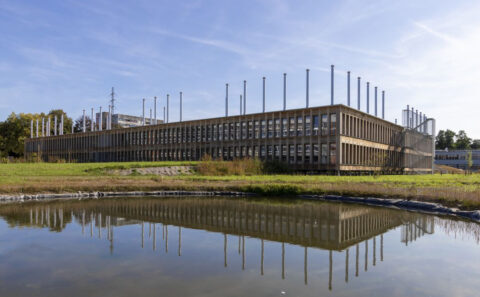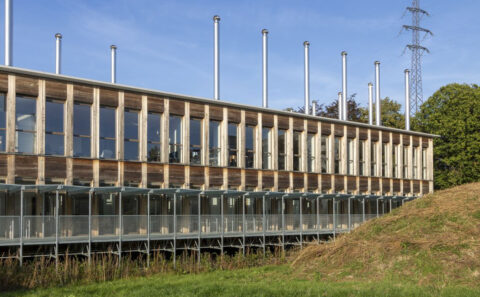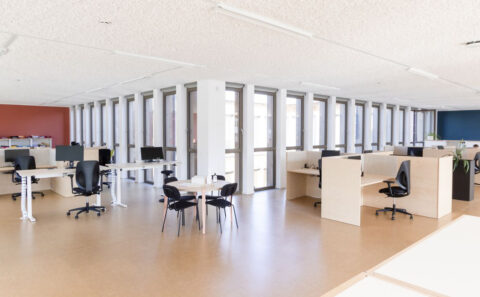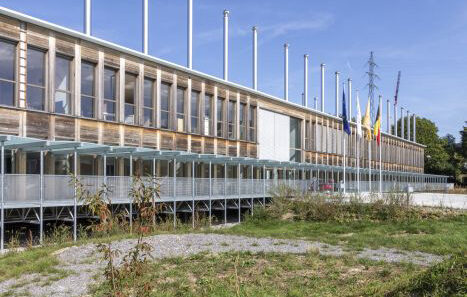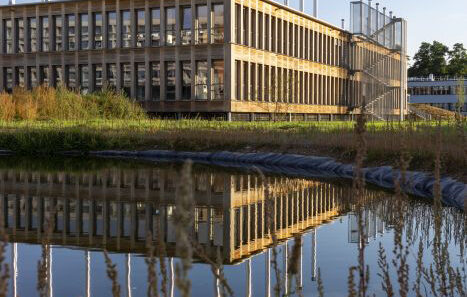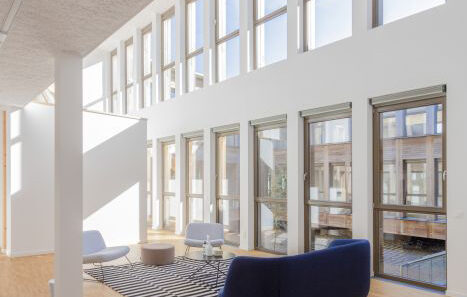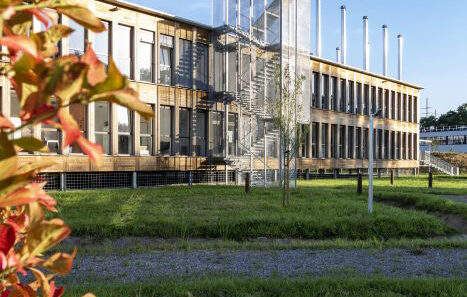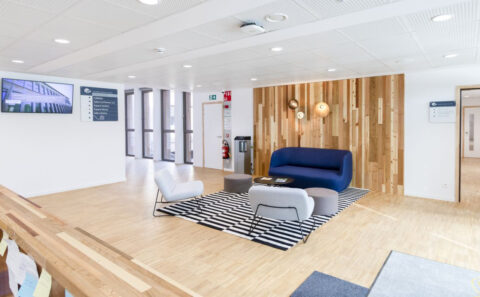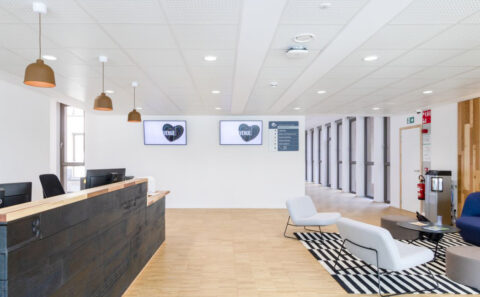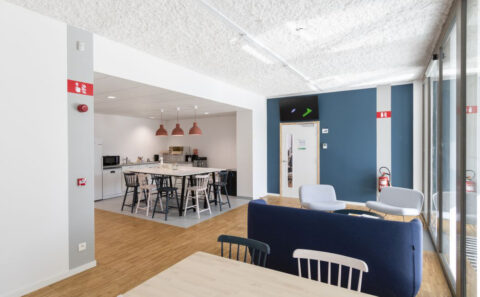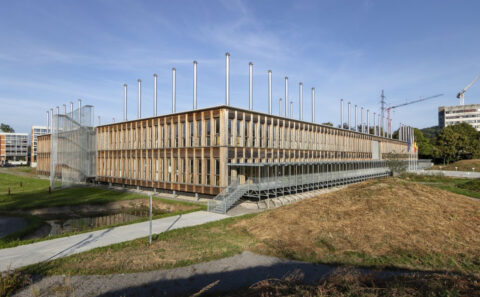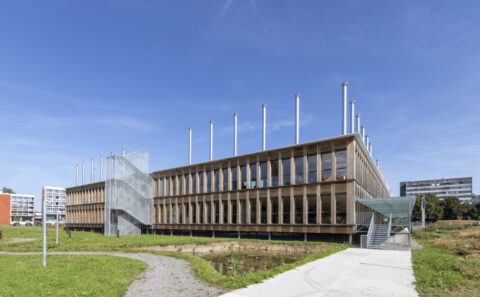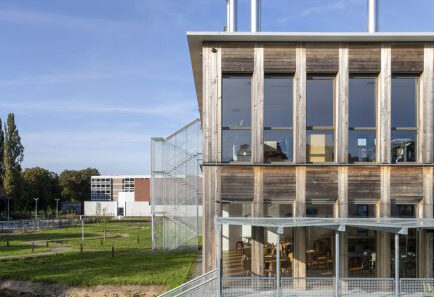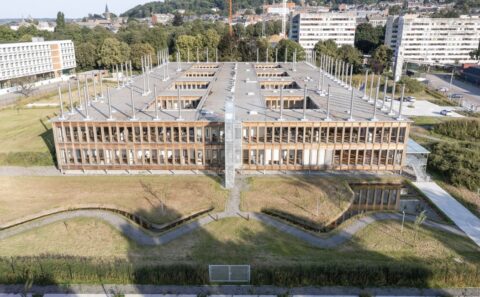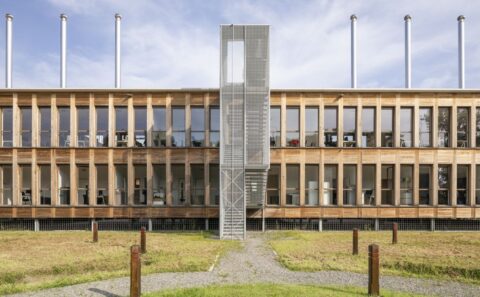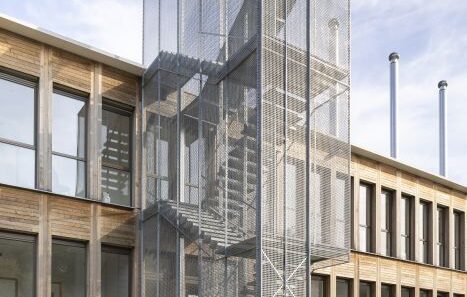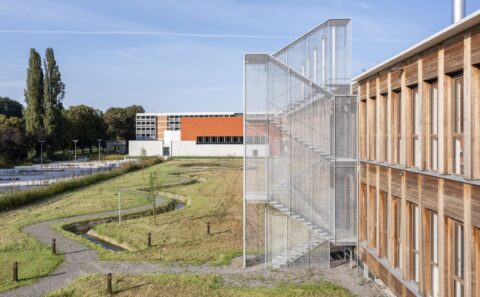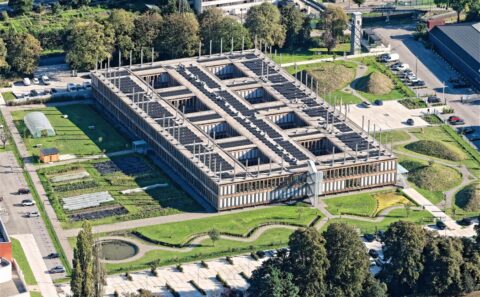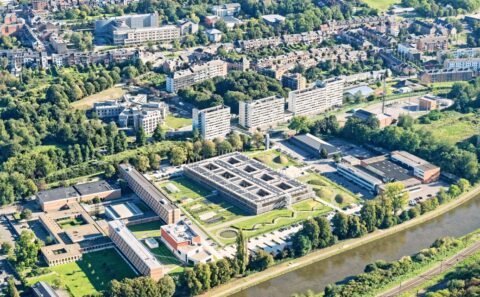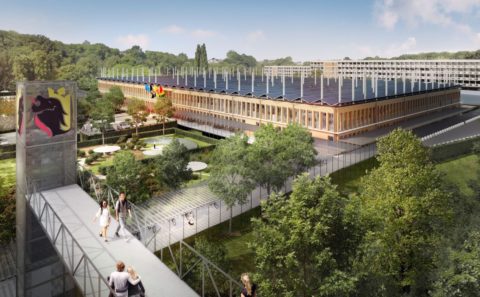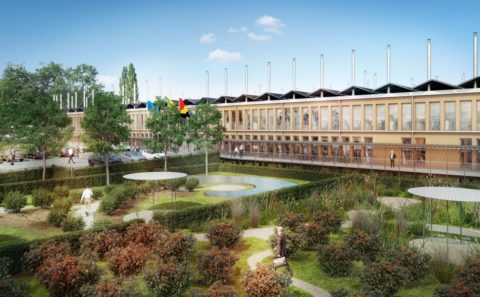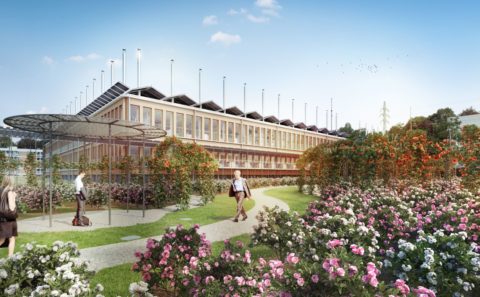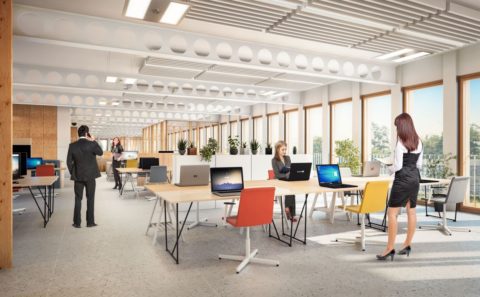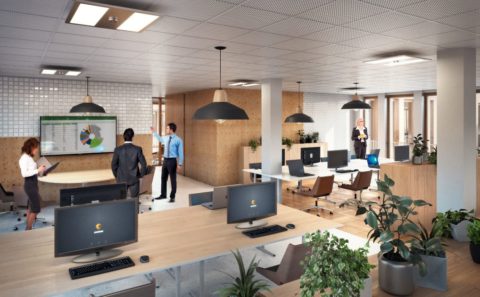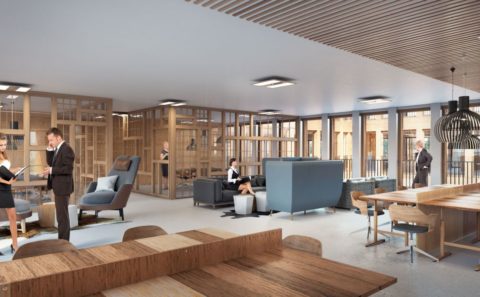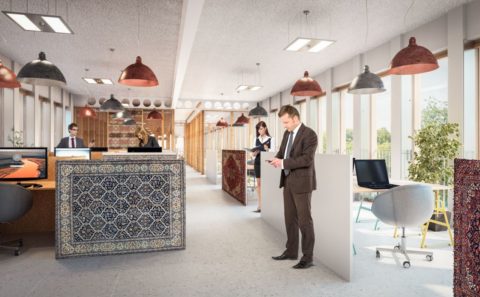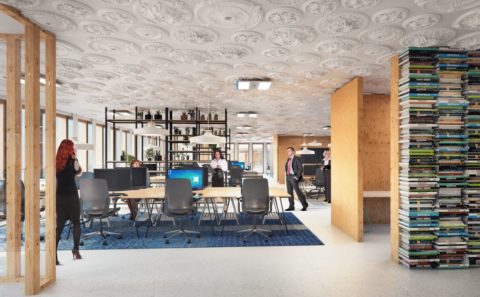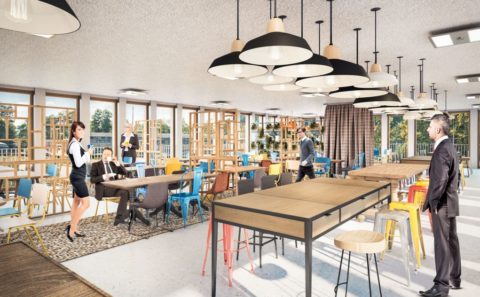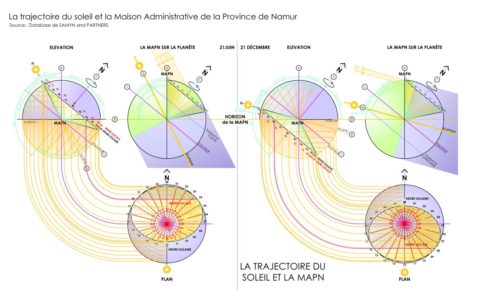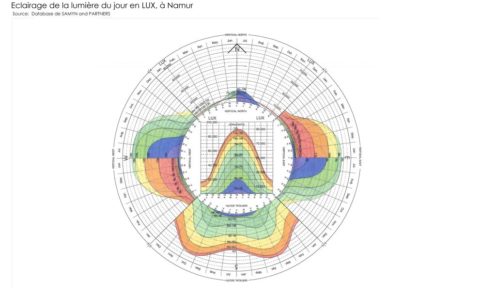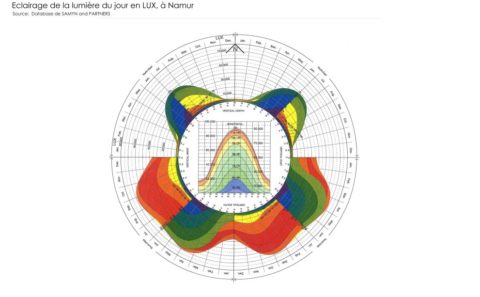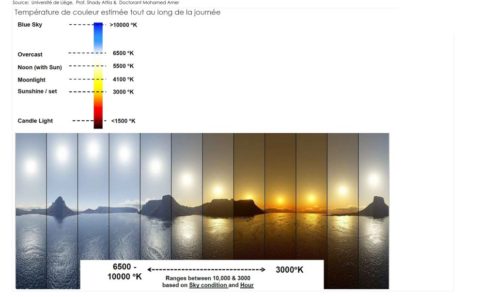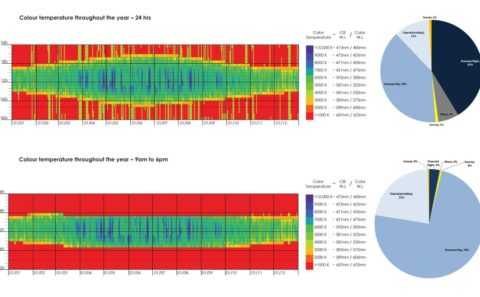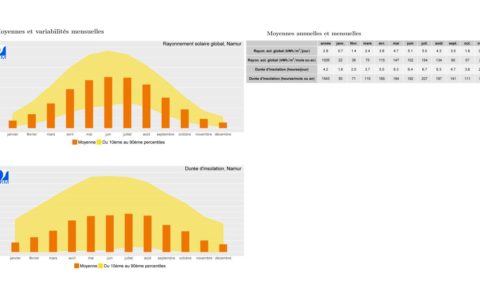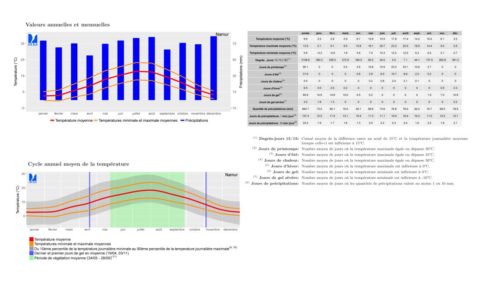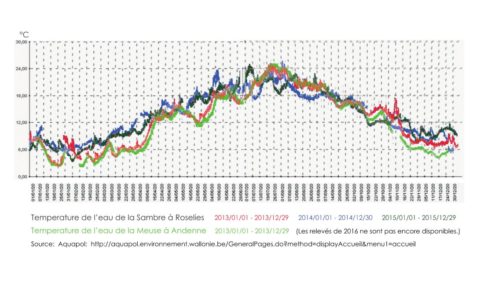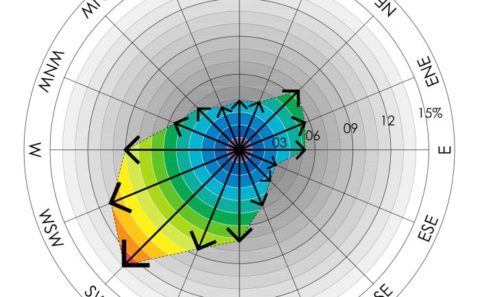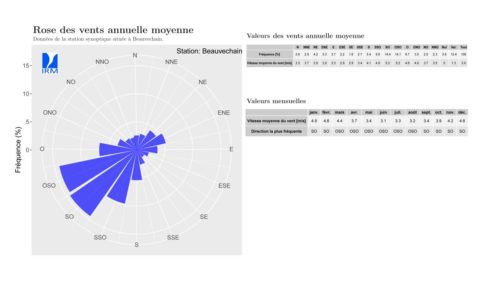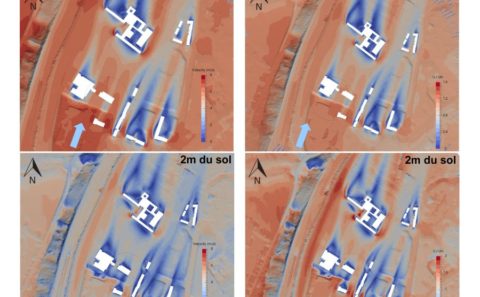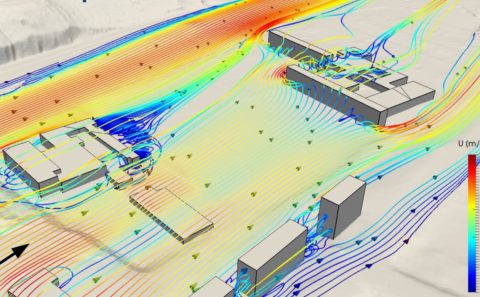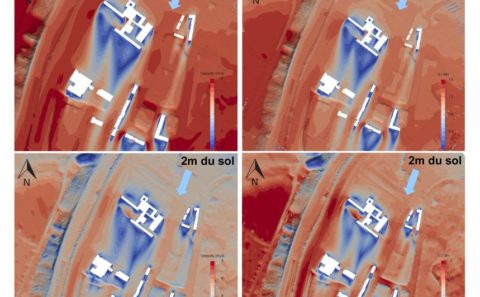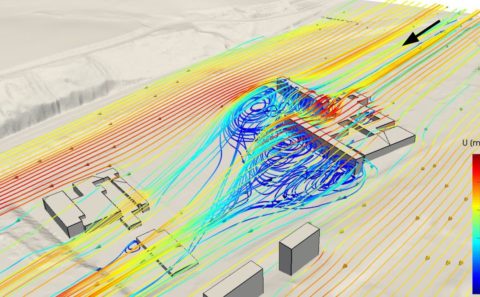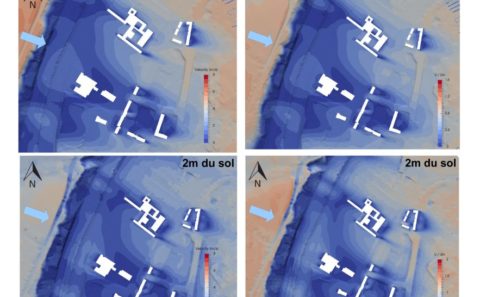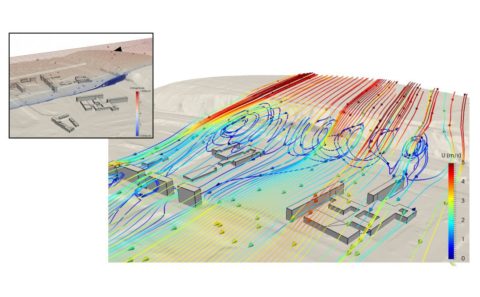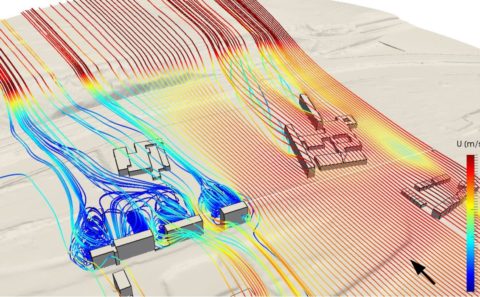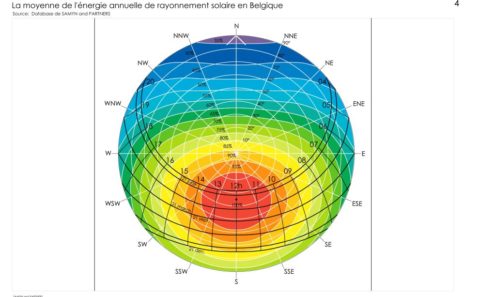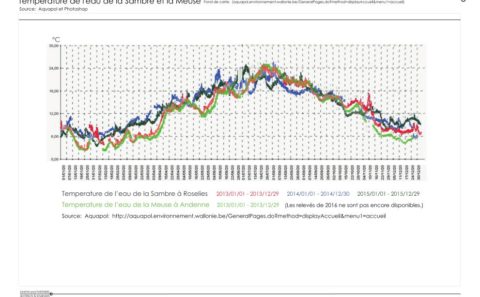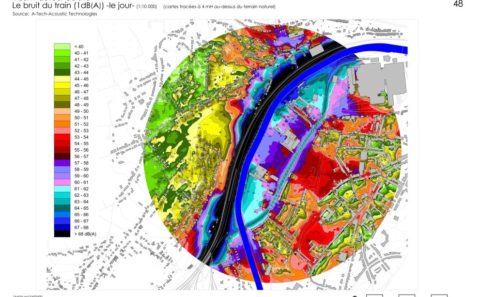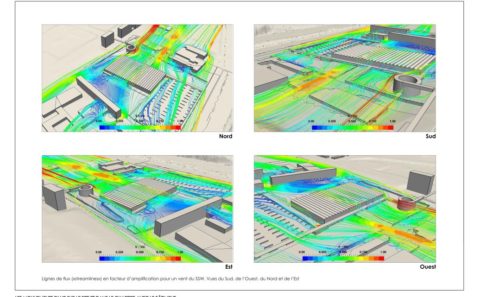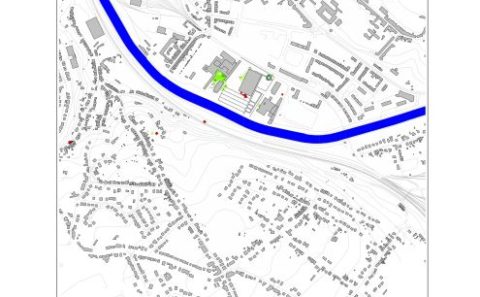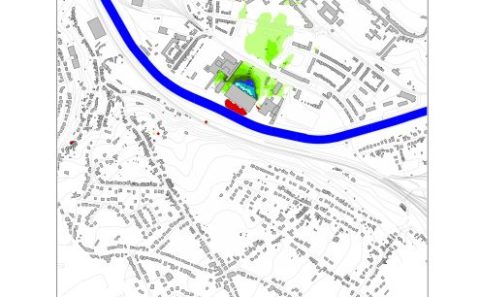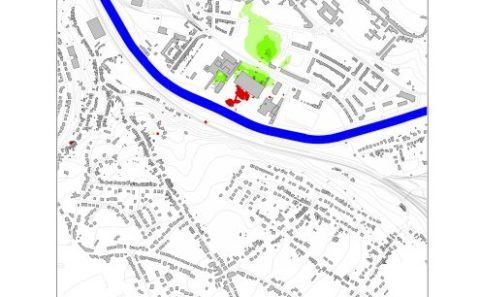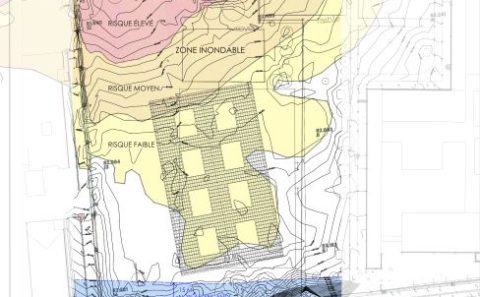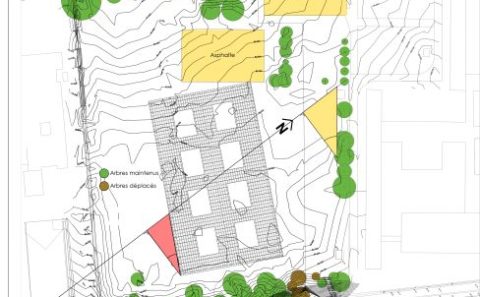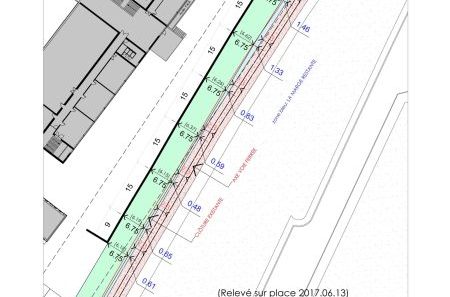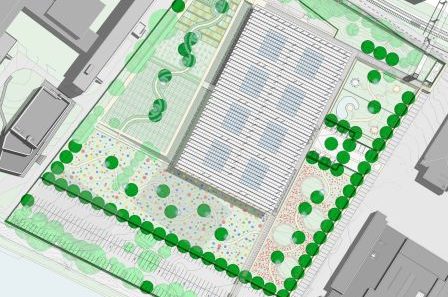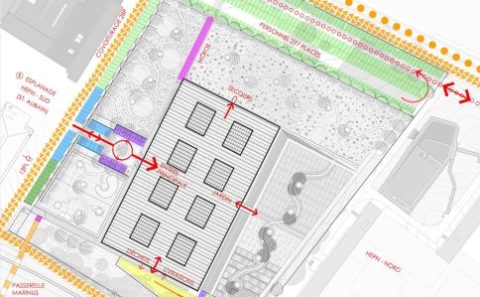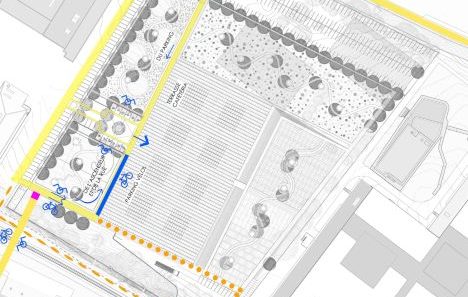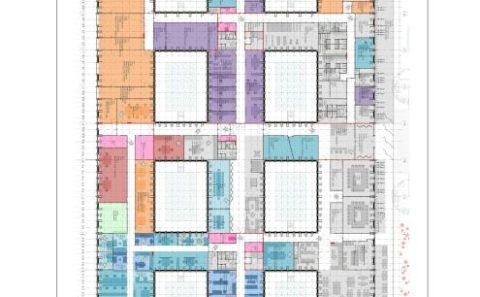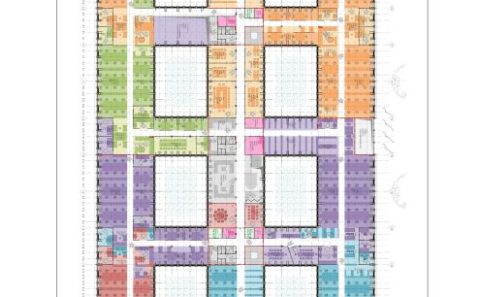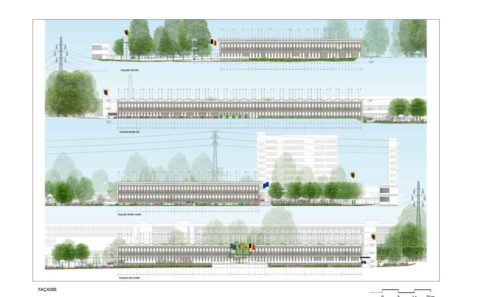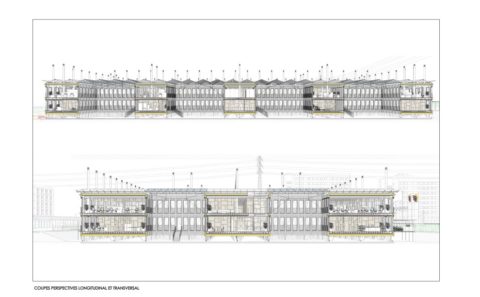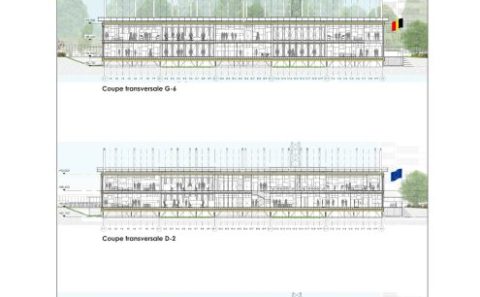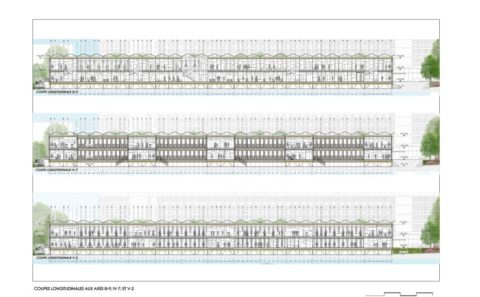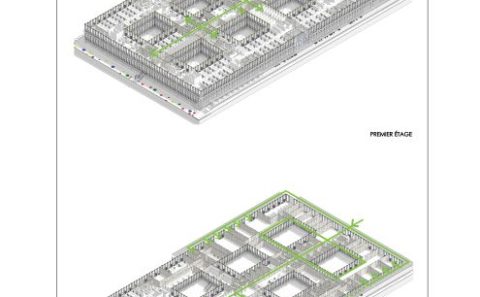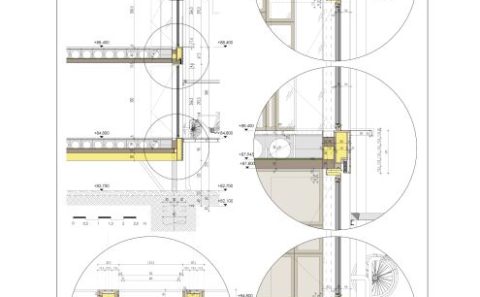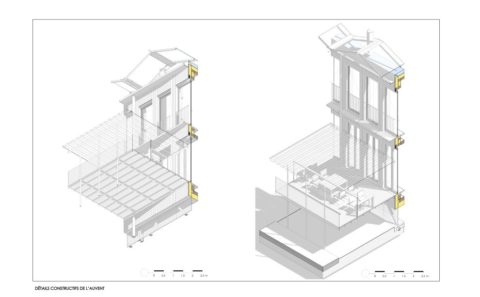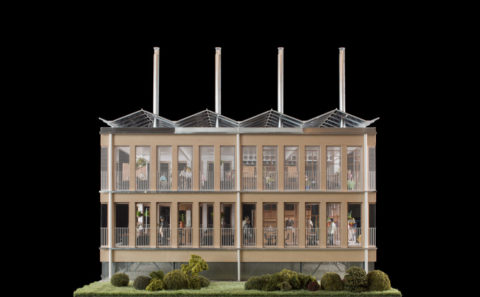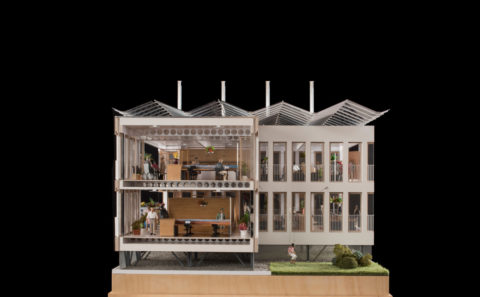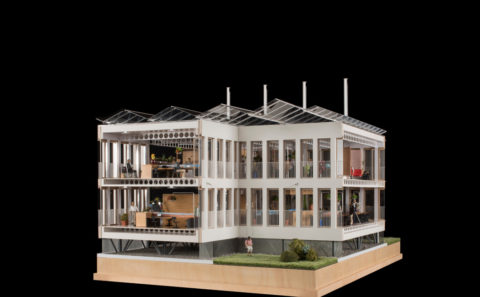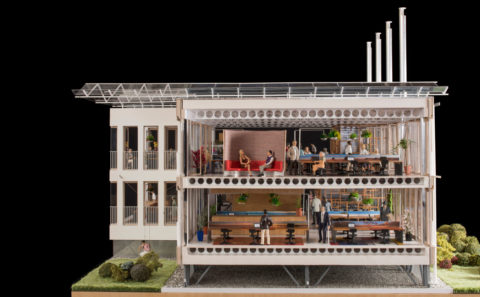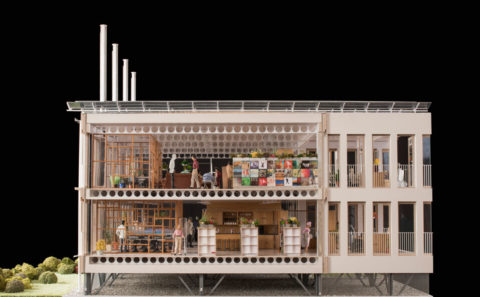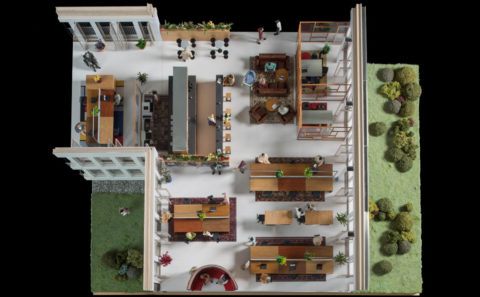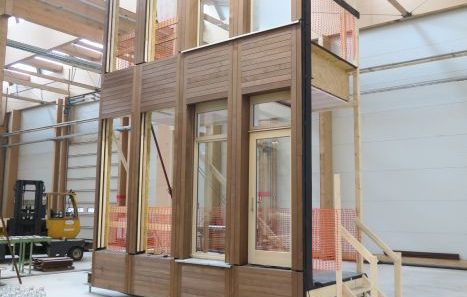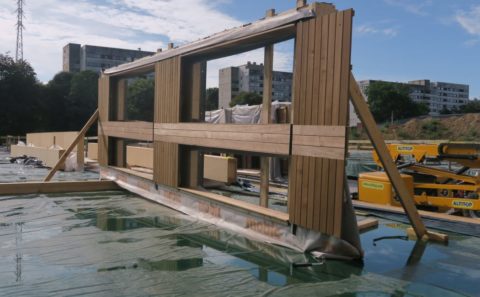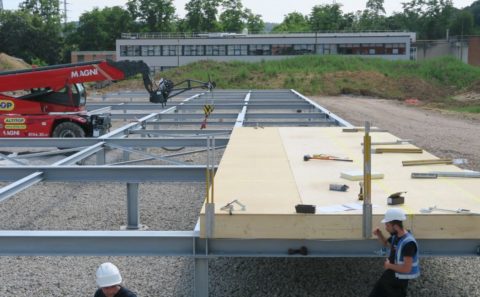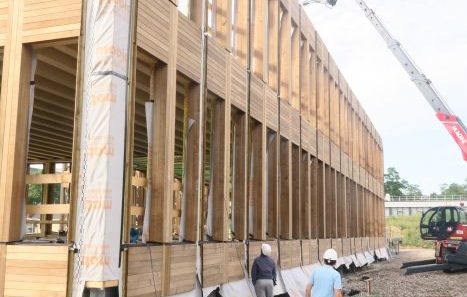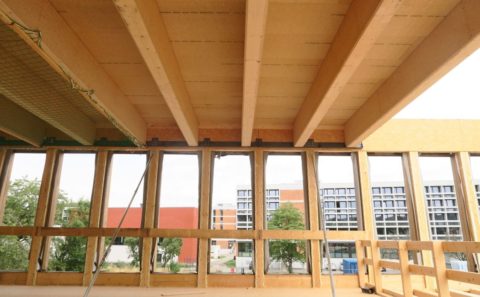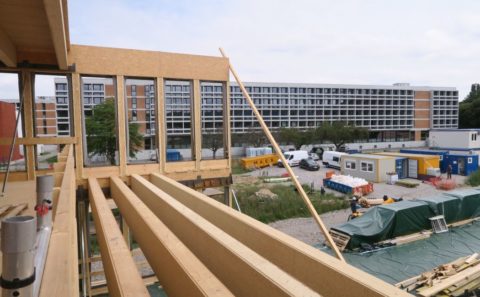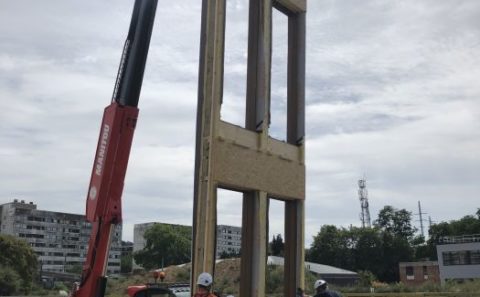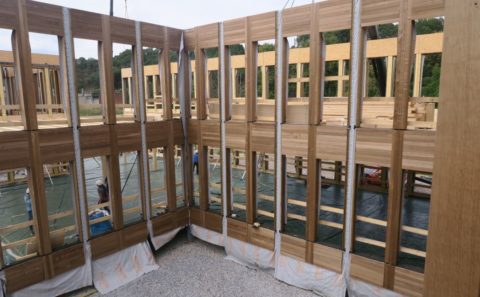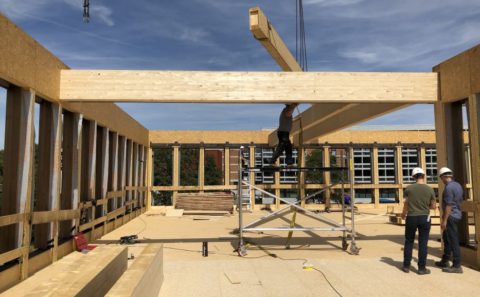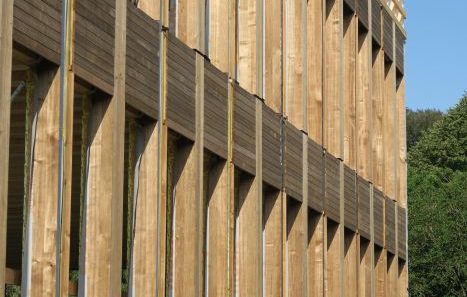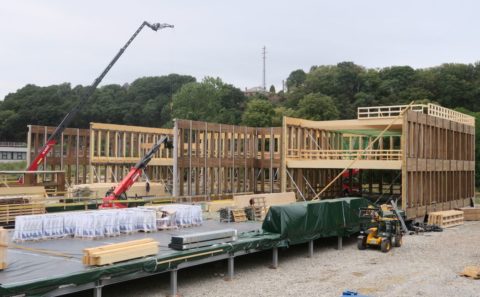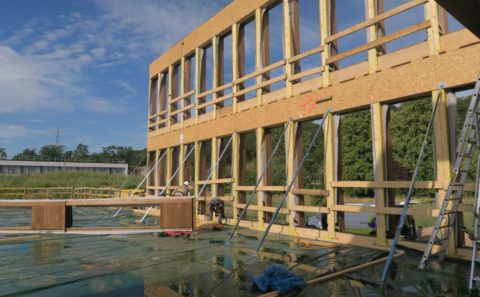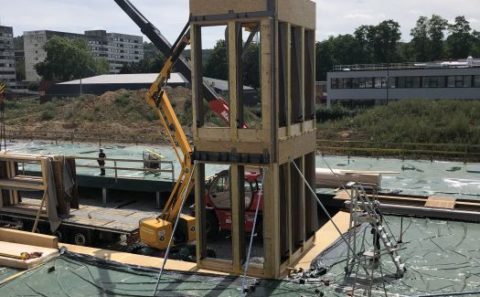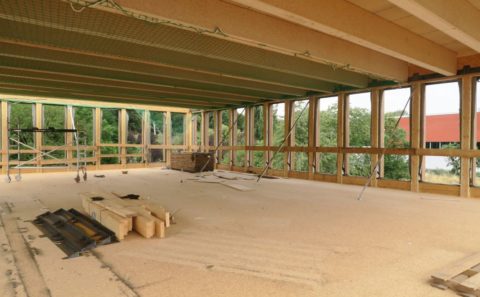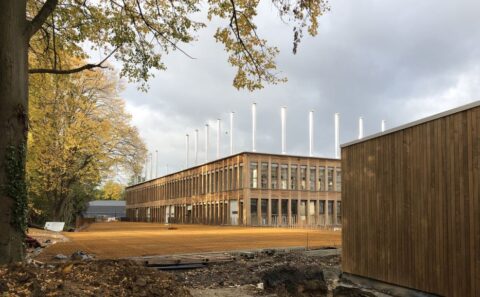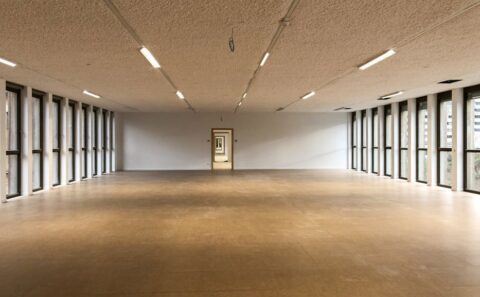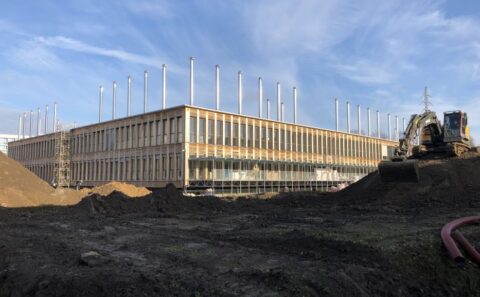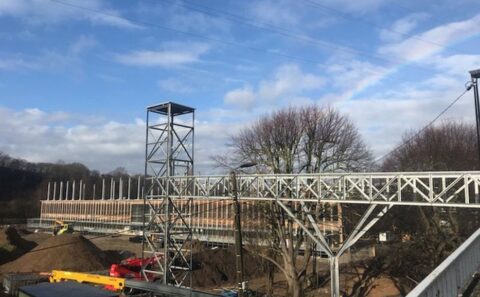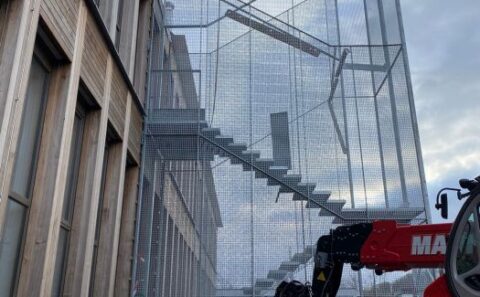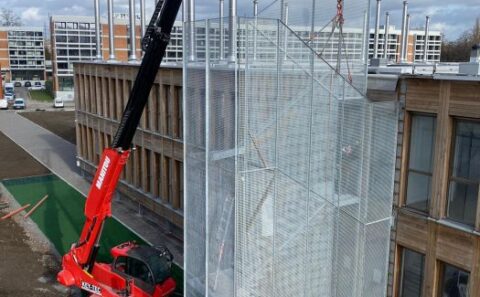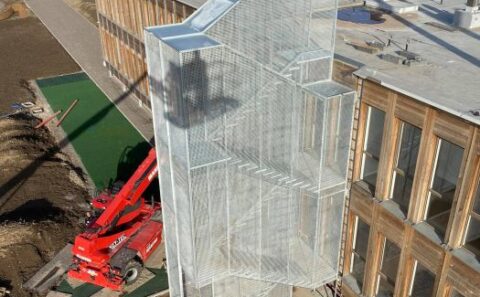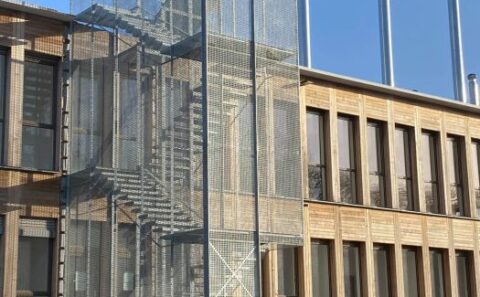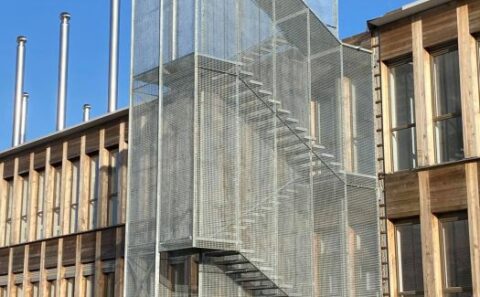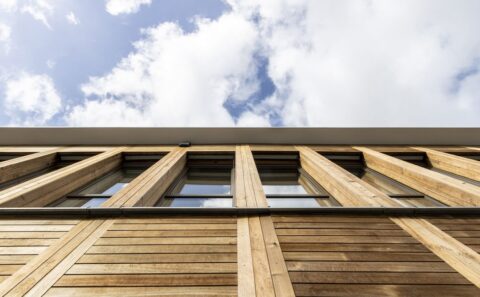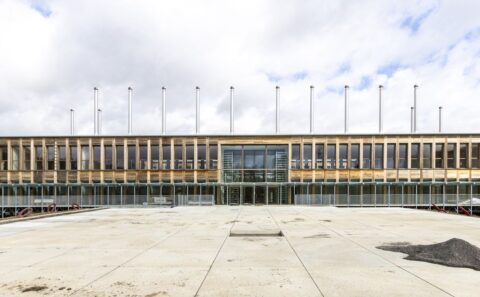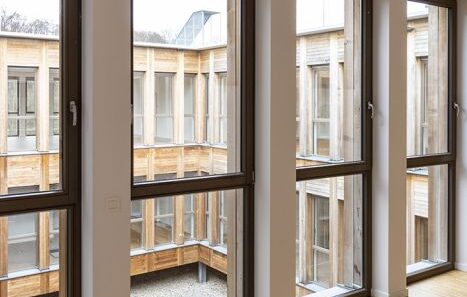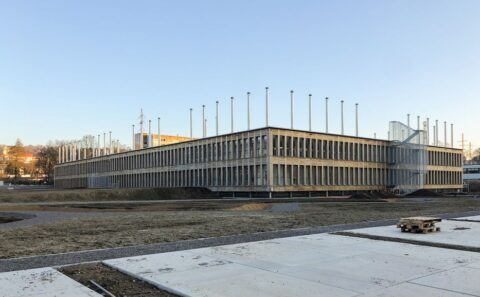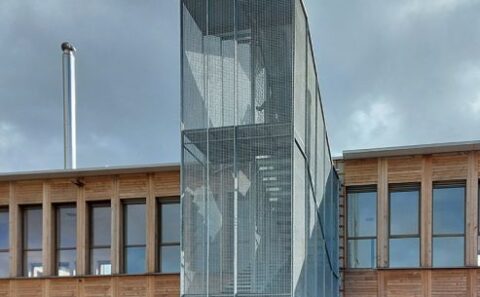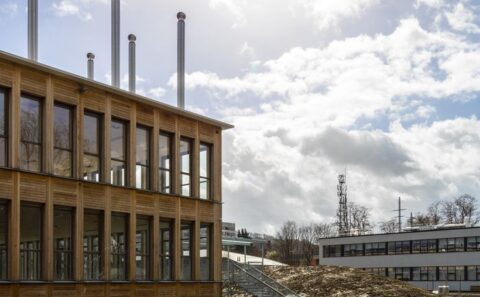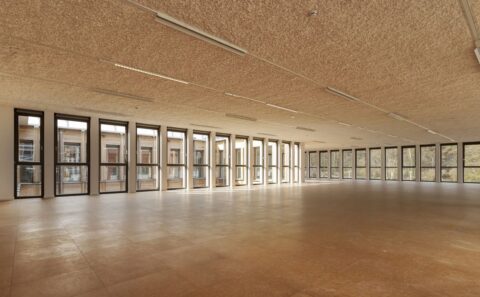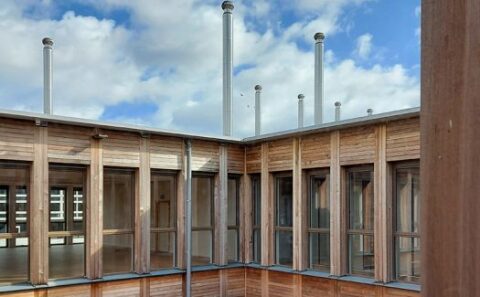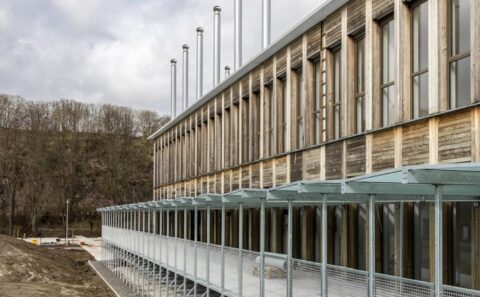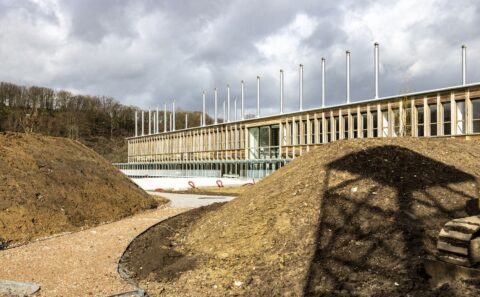© Simon Schmitt
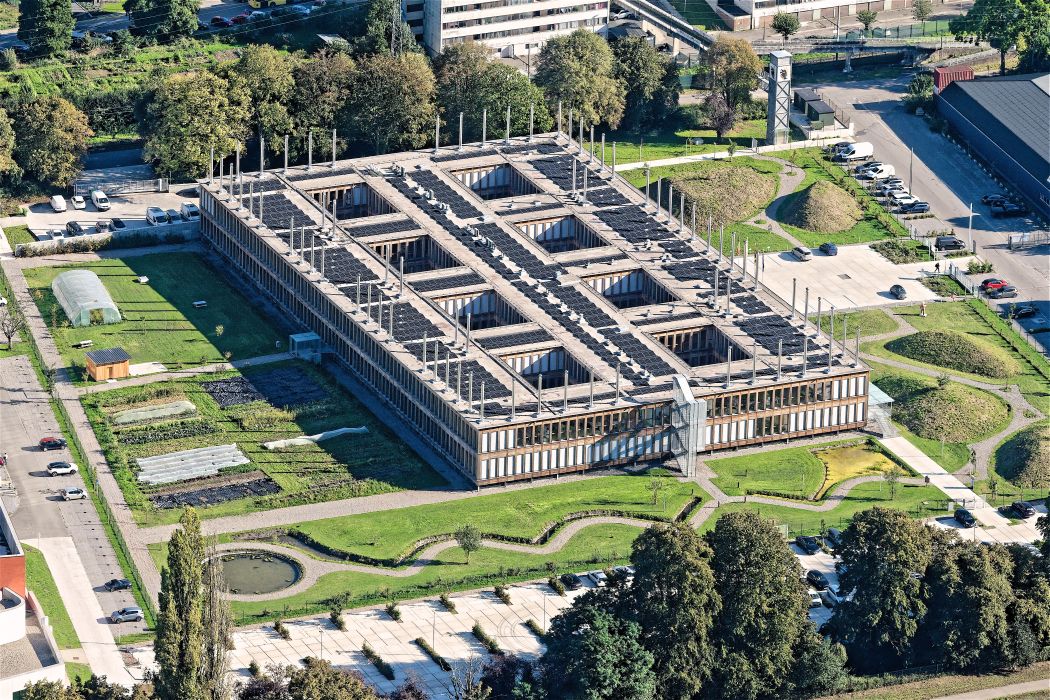
640 – ADMINISTRATIVE CENTRE FOR THE PROVINCE OF NAMUR
A construction site without towercrane, without dust, without noise, without water
Rue Henri Bodart, Salzinnes, Namur, Belgium
50°27’50”N / 4°50’14”E.
Building: 10.133 m²; land: 32.616 m²; 2017- 2021; (01/640).
Tender selected following a restricted call for “design and construction” tenders on behalf of Entreprises Jan De Nul.
- Urban planning
- History of the site
- Microclimate
- Hydrogeology
- Architecture
- Interior fittings
- Improvement of approaches and landscape design
- Structural engineering
- Building services engineering
- Technical commissioning of installations
- Building physics, EPB
- Energy Smart Grid
- Air quality
- Natural lighting
- BREEAM certification
- Acoustics
- Signs
- Accessibility
- Fire safety
Sponsor’s vision
A key socio-economic and cultural player, the Namur Province Administration is bringing almost all its services together in one building to be constructed at its Salzinnes site. By establishing itself on the outskirts and at the edge of the Sambre River rather than in a high-profile city centre Namur Province has plumped for a high-impact yet sensitive position, to reflect how it regards its role.
This site should act as a city-level focal point with the outlying area serving to complement the centre. Consequently, the idea is to create a structure that has the ability to generate a deep affection for this new intellectual centre in Namur.
The image that springs to mind is of a village centre reflecting the province’s rurality and symbiotic relationship with nature. An invitation to our five senses to experience pleasure through the channel of art and culture.
The construction of the Namur Province Administrative Centre (MAP) will involve huge financial and environmental costs. The project seeks to obtain the maximum number of BREEAM credits, while highlighting the limits of this approach, as well as the questions raised. The project achieves a score of 93.53 %, or 8.53 margin points above “Outstanding” level.
Genius Loci (Essence of Place)
Nestling in a hollow at a bend of the Sambre River, which surrounds it on the North-West flank, the site of the new MAP is bordered to the North-East by the former Major Seminary, an accomplished work by Roger Bastin, with simple yet refined elegance. Also worth mentioning, in the South-West, are the former Ecole Saint-Aubain and, in the South-East, a group of ten-storey housing blocks, a high-voltage line with one of the towers partially encroaching on the site and a secondary railway line providing access to the SNCB’s (Belgian National Railway Company) Ateliers Centraux de Salzinnes (Central Workshops of Salzinnes).
The emphasis the tender specifications place on urban agriculture, as a reflection of a centuries-old Namur tradition, adds an artistic and lyrical dimension to the project. The idea is for the entire North-eastern part of the site, or 3,300 m², to be earmarked for gardens and vegetable allotment gardening, in keeping with the existing urban allotments. Botanical science and technology in horticulture are teamed here with the skills of gardening, allotment gardens, orchards and nurseries, where shapes, colours, smells and flavours intermingle with the songs of birds and the sound of insects, as well as the play of shadows and light. Ventilation and natural lighting, plants and flowers, patinaed materials,… everything in the project is part of this movement.
Site
Taking the form of a large rectangle measuring 106.2 m x 61.65 m, the building is located as far as possible from the Sambre River, outside areas with a theoretical risk of flooding, at a good distance from the sound of the trains along the other bank.
It is understandably connected to the various possible access roads, whether it be rue Henri Bodart in the East, the route that may be created to the South-West along the side of the Sambre, or the pedestrian footbridge crossing the railway tracks in the South-East.
Its location also offers the breathing space required for both the Bastin Major Seminary and the buildings in the South-West.
The North-West / South-East diagonal layout ensures the best possible orientation of the facades and functions: work and cartage in the East, reception and ceremonial entrance in the South, festivities in the West (with the village square used as a car park) and conducive to dreaming or meditating in the North.
Everything is therefore established in a natural way, without any pointless complicated arrangements, in the style of a large farm or a small village.
Village building structured around patios
Built entirely of timber and steel on two 3.6-m-high levels, and resting on steel piles, the building is covered by a submerged roof for use as a water tower and topped by a photovoltaic sunshade.
The layout is based on eight rectangular patios measuring 15.3 m x 11.25 m on each side. Covered by operable greenhouse glass roofs, the patios provide fresh air to the building. Their white facades allow as much natural light as possible to enter and the glass roof can be open completely in the event of fire to change the covered patios into outdoor areas.
This arrangement allows the floor areas to be illuminated and provided completely with naturally occurring ventilation so they may be earmarked for a wide variety of programmes or functions.
The limited two-level structure ensures seamless communication between all parts of the building, so it is conducive to creating a team spirit, the “New World of Work” and easy access for people with reduced mobility.
The ground floor includes a welcoming reception area, a cafeteria with a capacity to accommodate 300 people, reception areas for visitors, a relaxation room and a fitness room with showers. This will all be rounded off with a large workshop, storage areas and changing facilities for maintenance staff.
The first floor houses most of the offices in different areas, as well as spaces conducive to concentration, various meeting rooms for teamwork, and relaxation areas to promote friendly exchanges among colleagues.
The four facades, all of which are made of wood, consist of gently alternating vertical support structures and open windows from the floor to the ceiling (110 cm wide on the inside and 101.25 cm wide on the outside). Fitted with railings, the operable windows allow everyone to enjoy a view of the gardens.
Orthogonal framework
The layout is rigorously organised on the basis of a structural framework measuring 1.35 m per side. The orthogonal design is almost naturally conducive to an archetypal layout for the main traffic routes: the “Cardo” from North to South and the “Decumanus” from East to West, much akin to Roman cities. It is from the central square, which is at their crossroads, that the activity spreads to the “districts”, then to the “neighbourhoods”.
The rigidity of the orthogonality is only apparent. It is simply the necessary and relevant basis for the free expression of diversity and lyricism. The sponsor’s vision smacks of nothing less than humanism and culture, thereby inciting us to propose this neutral structure to allow the gentle and joyful expression of diversity.
Harmonious diversity
The essential diversity of the interior spaces is created in the choice of finishing work, textiles, leathers, wallpapers, basketry, enhanced by artistic creations, rather than in the building structure and envelope. The walls, interior walls and partitions are covered, carpets of all kinds cover the floor, chandeliers, sculptures and other pleasant and useful objects may be hung from the wooden ceiling.
The same applies to the furniture (apart from furniture that falls specifically under the Code on Well-being in the Workplace, such as workstation seating). The project proposes pieces of furniture that are reused or made from materials provided by the Ressourcerie Namuroise but each of the occupants, may also suggest a chair, a table, a cupboard,… that expresses his/her personality, providing the proposals are discussed with other colleagues to ensure their wishes are respected.
The idea is to try relying only a second or third visual choice, re-use or recycling, making sure that this approach is socially and culturally valid, aspiring to a condition of lyricism, to invest the building with a soul and gain the affection of all users. The process must then be seen as setting an example for a public administration.
Naturally occurring ventilation
The aim of providing the best possible indoor climate with the smallest possible environmental footprint leads to the proposal to have the building naturally ventilated.
When, as in this case, outdoor air is of the appropriate quality, a naturally ventilated building is not only more pleasant but also more hygienic than ventilation achieved mechanically with air-conditioned air distributed through air ducts. It also turns out to be more cost-effective, both in terms of investment and operating and maintenance costs, with the main saving resulting from the absence of energy-using installations designed to move and cool air, notwithstanding the failure to recover energy from hot air extracted in winter.
Interior ventilation in cool weather is provided by static aerators at the top of the patio windows, with floor convectors at the base. The air is carried out by a natural draft system using chimneys installed every 4.05 m in the South and North facades, in the central East-West axis and in the centre of the three central wings.
On summer nights, free cooling (without a mechanical cooler) for the granito floors is ensured by operable patio windows, which are sheltered from the rain under the glass roofs.
Renewable energies
Only present-day technologies relying on solar energy and ground source heat pumps are viable for this project.
Solar thermal energy would be inefficient in this case. Wind power could mobilise the winds present at the site very efficiently, but would be too noisy. Cogeneration would duplicate solar and geothermal power. The river’s kinetic energy would be too low given the slowdown effect the locks create. Finally, the amount of biomass present on the site is too small to be turned into energy, whereas it is very useful as a fertilizer.
Parking, roads, access
The site car entrances (main entrance and parking entrance) are located in front of the building’s extensive South-West facade, from the roadway leading to the former Saint-Aubain Institute starting from rue Bodart. This roadway may be extended in the future along the Sambre River to the South in relation to avenue Woitrin.
Staff and visitors arriving from rue Marinus by public transit or bicycle can also use (as in the case of persons with reduced mobility) the lift located on an extension of the footbridge in the South-East corner of the site to reach the main entrance through a covered gallery. The heavy vehicle entrance is located in the North-East corner of the site.
Twelve of the 371 car parking spaces, are earmarked, near the entrance, for persons with reduced mobility and 30 for visitors, 12 are provided with electric charging stations, 28 are earmarked for carpooling and 12 (one of which for persons with reduced mobility) are allocated, in the delivery area, to staff. There are 30 parking spaces for motorcycles close to the “village square” and 103 covered bicycle parking spaces under the awnings and galleries.
Approaches
The open ground is all earmarked for market gardening and staff recreation (sports fields could also be considered). It consists of different gardens divided into three parts:
- a) in the North-East: the teaching garden, with its open ground growing area (next to the greenhouse and nursery) and its box growing area, as well as the vegetable production garden for staff;
- b) in the North-West: the large garden created for biodiversity and relaxation purposes with its fitness trail and customised ‘insect hotels’ (as much as possible of the existing asphalt area is being repurposed, and artistically treated so as not to destroy it);
- c) in the South-West: the scented rose garden and the therapy garden.
(1262)* – Province de Namur. Demande de participation à l’appel d’offre pour la nouvelle “Maison de la Province”. SM Eraerts – Jan De Nul/Samyn et Associés, 2016-11-09, 373 p. “Avis de marché” : BE001-20/9/216-Numéro BDA : 2016_528547″; 15p. Courrier recommandé de la Province en date du 2016-12-12, 2p plus une page annexe. Réponse à la demande de renseignement du 2016-12-12; 2017-01-16, 145p. Courrier recommandé de la Province en date du 2017-02-16 annonçant selection; 1p, plus 21p annexes (01/640); (BE).
(1315) – Revue de presse et divers concernant la Maison Administrative de la Province de Namur (01/640) :
SURFACES
Surface brute : 10.133 m².
Surface terrain : 32.616 m².
MAÎTRE D’OUVRAGE
Province de Namur, Place Saint-Aubain n° 2, 5000 Namur, Belgique.
Assistant à maîtrise d’ouvrage : BEP – Département Développement Territorial,
Avenue Sergent Vrithoff n° 2, 5000 Namur, Belgique.
Personne de contact : Alain Stevens, Tél.: +32 81 71 71 62, E-mail : ast@bep.be.
Design and Build avec Jan DE NUL nv, Tragel 60, 9308 Hofstade-Aalst, Belgique.
Personne de contact : Jean-Pierre Mouchet, Tél.: +32 71 37 69 29, +32 477 65 01 25, +32 53 73 15 11,
E-mail : jean-pierre.mouchet@jandenul.com.
ARCHITECTES & INGÉNIEURS
Philippe SAMYN and PARTNERS sprl, architects & engineers, Philippe Samyn
Chaussée de Waterloo, 1537, 1180 Bruxelles, Belgique. Propriétaire exclusif des droits d’auteur (copyright)
Tél. : + 32 2 374 90 60, E-mail: sai@samynandpartners.com,
ÉQUIPE DE CONCOURS
Architecture
Dir. générale et conception : Dr Ir Philippe Samyn.
Dir. administration : Quentin Steyaert.
Dir. technique : Denis Mélotte
Dir. NWOW : Åsa Decorte.
Dir. BIM : Åsa Decorte.
Associés consultants : Jacques Ceyssens, Benedetto Calcagno, André Charon, Ghislain André.
Collaborateurs : Soumil Adhatrao, Karim Ammor, Gabriel Baltariu, Sam De Dobbeleer, Mirela Gancheva, Cristina Ibanez Moreno, Ali Laghrari, Robin Lejeune, Ana Miralles Barreda, Quentin Olbrechts, Radu Somfelean, Raúl Villafáñez, Juliette Yaramis.
Ingénierie Stabilité
Philippe SAMYN and PARTNERS sprl, architects & engineers, avec en sous-traitance le Bureau d’étude Cerfontaine, sprl, Ir David Janssen, Rue de Herve n°250, 4030 Liège, Belgique, Tél.: +32 4 344 47 65, +32 474 23 98 43
E-mail : d.janssen@becerfontaine.be, info@becerfontaine.be.
Ingénierie Techniques Spéciales
Philippe SAMYN and PARTNERS sprl, architects & engineers, avec en sous-traitance FLOW TRANSFER INTERNATIONAL sa, Andrew Janssens, Rue du Ham n°137, 1180 Bruxelles, Belgique, Tél.: +32 2 375 75 40, E-mail : info@fti-sa.be.
Conseillers en sous-traitance de Philippe SAMYN and PARTNERS sprl :
Conseiller historique
Philippe Bragard, Rue Ernotte n° 5, 5000 Namur, Belgique,
Tél.: +32 476 52 94 87, E-mail : philippe.bragard@uclouvain.be.
Conseiller Urbanisme
Université de Liège, Prof. Dr Ir Arch. Jacques Teller
Chemin des Chevreuils n°1, B52/3, 4000 Liège, Belgique,
Tél.: +32 4 366 93 94, E-mail : Jacques.teller@ulg.ac.be.
Conseiller Agriculture Urbaine
Gembloux Agro-Bio Tech Université de Liège, Ir Dr Bach Kim Nguyen,
Passage des Déportés n°2, 5030 Gembloux, Belgique,
Tél.: +32 498 13 15 69, E-mail : bk.nguyen@ulg.ac.be.
Conseiller Energy Smart Grid
Université de Liège, Prof. Dr Ir Damien Ernst,
Montefiore Institute (Building B28) Quartier Polytech 1, Allée de la découverte n°10,
4000 Liège, Belgique,
Tél.: +32 4 366 95 18, +32 493 04 25 68, E-mail : dernst@ulg.ac.be,
avec
EnergyPonics sprl, Ir Christophe Druet,
Rue de la Vallée n°83, 5060 Sambreville, Belgique,
Tél.: +32 479 97 74 48, E-mail : christophe.druet@EnergyPonics.com
Simulations dynamiques et micro-climats
Cenaero, Dr Cécile Goffaux, Ir Arnaud Candaele, Ir Kevin Siau,
Rue des Frères Wright n°29, B-6041 Gosselies, Belgique,
Tél.: +32 071 91 09 30, E-mail: info@cenaero.be.
Hydrogéologie
Aquale sprl, Ing. Thierry Duren, Ir Julien Peret,
Ecofox Développement, Rue Ernest Montellier n°22, 5380 Noville-les-Bois, Belgique,
Tél.: +32 81 83 01 20, +32 497 06 30 37 (TD), +32 496 18 38 20 (JP),
E-mail: infos@aquale.com, t.duren@aquale.com ; j.peret@aquale.com.
Qualité de l’air
Certech , asbl. Laurent Bilteryst, Sébastien Moro,
Rue Jules Bordet, zone industrielle C, 7180 Seneffe, Belgique,
Tél.: +32 64 520 211, +32 476 32 20 87 (SM),
E-mail: laurent.bilteryst@certech.be, sebastien.moro@certech.be.
Physique du bâtiment et conseiller PEB
Matriciel sa, Ir Fabrice Derny,
Place de l’Université 25, 1348 Louvain-la-Neuve, Belgique,
Tél.: +32 10 24 15 70, +32 474 62 75 53 (FD), E-mail: derny@matriciel.be.
Conseiller acoustique
Acoustic Technologies sa, Jean-Pierre Clairbois,
Avenue Brugmann, 215, 1050 Bruxelles, Belgique,
Tél.: +32 2 344 85 85, E-mail : mail@atech-acoustictechnologies.com.
Éclairage naturel
Sustainable Bulding Design Lab, Université de Liège, Prof. Dr Arch. Shady Attia, Ir Arch. Mohamed Amer,
Quartier Polytech 1, Allée de la Découverte n° 9, 4000 Liège, Belgique,
Tél.: +32 4 366 91 55, +32 468 21 61 00, +32 479 89 43 79,
E-mail : shady.attia@ulg.ac.be, m_amerhegazy@hotmail.com.
Conseiller Éclairage extérieur
Magic Monkey sprl/bvba, Marc Largent,
Rue Franz Merjay, 179, 1050 Bruxelles, Belgique,
Tél.: +32 2 344 84 84, E-mail : marc.largent@ magicmonkey.
NWOW
Veldhoen + Company bv, Luc Kamperman,
Akkerstraat n° 22, 5582 HC Waalre, Pays-Bas,
Tél.: +31 88 44 47 222, +31 6 5202 7249 (LK),
E-mail: mail@veldhoencompany.com, luc@veldhoencompany.com.
Architecture d’intérieur
Dinterieur sprl, Dominique Hottois, Caroline Bus, Angeline Hayois,
Rue du Striquet, 2, 1331 Rosières, Belgique,
Tél.: +32 2 652 36 56, +32 477 67 50 14 (DH), +32 474 71 38 83 (CB), +32 474 23 43 10
(AH), E-mail : dh@dinterieur.be; cb@dinterieur.be, ah@dinterieur.be.
Conseiller cuisine
F&BO, Freddy Oushoorn,
Doornzele Dries 122, 9940 Evergem, Belgique,
Tél.: +32 9 253 62 33, +32 475 26 71 39 (FH), E-mail: fbo@telenet.be.
Conseiller accessibilité PMR
Plain-pied asbl, Julie Vanhalewyn, Rue Nanon, 98, 5000 Namur, Belgique,
Tél.: +32 81 39 06 36, +32 478 79 41 02, E-mail : julie.vanhalewyn@plain-pied.com.
Coordinateur Sécurité – Santé
Cosep sa, Ir Arch. Benoît Van Hoye, Arch. Thaddée van Oost,
Rue du Fond Cattelain n°5, 1435 Mont-Saint-Guibert, Belgique,
Tél.: +32 10 81 37 50, Fax: +32 10 84 24 50, E-mail: cosep@cosep.be.
Signalétique
Sdesign sprl, François-Joseph de Lantsheere,
Rue Franz Merjay 148 C, 1050 Ixelles, Belgique,
Tél.: +32 2 223 41 90, +32 477 79 72 34, E-mail : info@sdesign.be.
Sûreté et sécurité des accès
ROBRECHTS & THIENPONT, Ir Marc Thienpont,
Rue du bois de Gonrieux, 4, 5660 Cul-des-Sarts, Belgique,
Tél.: +32 60 37 77 82, +32 475 255 271 (MT), E-mail : mt@rtconsultancy.be.
Sécurité incendie
Technical & Data Consulting (TDC), Ir Didier Vander Brugghen, Ir Arch. Benoît Bastin,
Rue Driesstraat 167, 1200 Bruxelles, Belgique,
Tél.: + 32 2 674 28 01, + 32 2 674 28 00, + 32 2 476 98 82 56,
E-mail: info@tdconsulting.be; dvb@tdconsulting.be(DVB), bbastin@tdconsulting.be (BB).
Conseiller BREEAM
B4F sprl, Ir Arch. Perihan Tulumoglu, Ing. Nicolas De Foy,
Drève du Duc n°57-59, 1170 Bruxelles, Belgique,
Tél.: +32 2 673 92 85, +32 489 516 890 (PT), +32 478 27 09 57 (ND),
E-mail : info@b4f.eu, E-mail : Perihan@b4f.eu, E-mail : Nicolas@b4f.eu.
Images de synthèse
ASYMETRIE sprl, Xavier Vanabelle, Michaël Barrin,
Rue de Thirimont, 126, B-6511 Beaumont, Belgique,
Tél : +32 71 31 43 00, E-mail : contact@asymetrie.be.
Maquette
Philippe SAMYN and PARTNERS sprl, architects & engineers, avec en sous-traitance Mini-Vitrines, Valérie Van den Bergen,
Rue de Malonne n°19b, 5150 Floreffe,
Tél.: +32 81 74 55 64, E-mail : info@minivitrines.com.
Photographies de la maquette
Jean-Michel Byl, Rue du sceptre n°23, 1050 Bruxelles, Belgique,
Tel : +32 475 23 04 56, Email : jmb@archipictures.be.
DOCUMENTATION
Gestion documentation : Philippe SAMYN and PARTNERS (André CHARON et Quentin OLBRECHTS)
CHRONOLOGIE DU PROJET
Date de sélection de la candidature Equipe « Eraerts -Jan De Nul + Samyn et Associés » : 2017-02-16.
Date de remise de l’offre : 2017-09-11.
BUDGET HORS HONORAIRES ET TVA
16 100 957 €
All documents are in French, available on our FTP server.
(1262) – Maison Administrative de la Province de Namur (01/640) (BE) :
- Demande de participation à l’appel d’offre pour la nouvelle “Maison de la Province”. SM Eraerts – Jan De Nul/Samyn et Associés, 2016-11-09, 373 p. “Avis de marché” : BE001-20/9/216-Numéro BDA : 2016_528547″; 15p. Courrier recommandé de la Province en date du 2016-12-12, 2p plus une page annexe. Réponse à la demande de renseignement du 2016-12-12; 2017-01-16, 145p. Courrier recommandé de la Province en date du 2017-02-16 annonçant selection; 1p, plus 21p annexes (01/640);
- Cahier spécial des charges du marché public de travaux ayant pour objet « La conception et l’équipement de la Maison Administrative de la Province de Namur, ainsi que l’aménagement de ses abord” (85 p. Din A4) et ses annexes : Annexe 1 : Relevé photographique du site (3 Din A3) Annexe 2 : Programme fonctionnel – Tableau Excel des surfaces à compléter : Notice programme des besoins (33 p. Din A4). Détail du programme des besoins (4 tableaux Din A3). Récapitulatif des surfaces (1 tableau Din A4). Tableau des surfaces à compléter (1 tableau Din A4). Interactions et proximités (2 tableaux Din A4). Définition des types de surfaces (9 p. Din A4) Annexe 3 : Liste des documents à joindre à l’offre (4 p. Din A4) Annexe 4 : Levé de terrain et périmètre d’action Annexe 5 : Etude urbanistique et analyse cartographique (29 p. Din A4 et 13 planches Din A3) Annexe 6 : Impétrants et données techniques Annexe 7 : Canevas métré (2 p. Din A4) Annexe 8 : Partie environnementale – Tableaux Excel à compléter (6 p. Din A4) Annexe 9 : Parking. Expertise de prédimensionnements Transitec (10 p. Din A4)
- Philippe Samyn : “Le projet pour la Maison Administrative de la Province de Namur” (01/640). (Document h1 et ses annexes ; 1289 pages). “Note synthétique générale”. (Pièce technique n°a)1 ; 12 p.) ; 2017-09-11 ; (BE).
- « Marché relatif à la conception et l’équipement de la Maison Administrative de la Province de Namur, ainsi que l’aménagement de ses abords – Information – Offre retenue » Courrier recommandé de la PROVINCE de NAMUR, Service Techniques & Environnement, PATRIMOINE IMMOBILIER, à Jan De Nul NV, en date du 2017-12-07 sous références : 259/2017/JPhC/CP, 2p ; avec deux annexes : a) « PROVINCE de NAMUR, Service Techniques du Patrimoine Immobilier – La Maison Administrative de la Province de Namur – (Conception, construction, équipement et aménagement de ses abords) – Approbation de l’attribution du marché à la S.M. ERAERTS – JAN DE NUL de 6220 FLEURUS au montant de 21.229.475,35 € FGC » 2017-12-07, 22p et ; b) « PROVINCE de NAMUR, RAPPORT D’ATTRIBUTION – 2ème phase – Dossier n°2016/MAP – Marché Public de Travaux – « LA CONCEPTION ET L’EQUIPEMENT DE LA MAISON ADMINISTRATIVE DE LA PROVINCE DE NAMUR, AINSI QUE L’AMENAGEMENT DE SES ABORDS – APPEL D’OFFRE RESTEINT» non daté, 79p ; (BE).
For plans sections and elevations, please refer to the archives section of the site available from the “references” menu.


